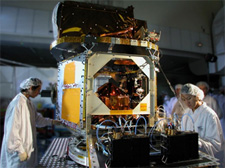THEOS and GÉANT enabling scientists to monitor and mitigate natural disasters
The Challenge
 Thailand is subject to a disaster cycle that needs monitoring – from forest fires and drought in the dry season to landslides and flooding in the rainy season.
Thailand is subject to a disaster cycle that needs monitoring – from forest fires and drought in the dry season to landslides and flooding in the rainy season.
In 2011, the system was put to the test when serious flood risks hit Bangkok. Thailand’s Geo Informatics and Space Development Agency (GISTDA) needed guaranteed frequent, fast and reliable data transmission of large satellite images between Sweden and Thailand - particularly important in time-critical disaster mitigation and response applications.
The Solution
THEOS images were used to build flood maps to determine and predict the flow of water. The resulting water map was combined with a terrain model for more accurate prediction.
The only way to transfer these large images quickly and reliably is through high-speed dedicated research and education networks between Sweden and Thailand. The data is routed over inter-connected national and regional research and education networks.
The images were used to issue flood warnings to the public and guide the opening and closing of water gates to control the flow of water. This provided a visual display to describe the situation to senior government officials and the public.
|
|
Raw THEOS images are transmitted to the Swedish Space Corporation’s Ground Receiving Station in Kiruna, Sweden and returned to Thailand for processing. Situated at a very high latitude of 68" N, the Swedish ground station can communicate with the satellite more frequently than GISTDA’s own ground station.
GISTDA transfers an average of 5GB daily, and also using the TEIN and GÉANT links the transfer rate is almost 10Mbs end to end.
Key Benefits
Providing a high-quality connection with no data loss, research and education networks minimises the time needed to transfer data between the two sites in response to an emergency situation.
|
"Without TEIN and GÉANT we would have to resort to transferring the imagery data over the commercial internet which will be less secure and definitely more time consuming. Prior to the connection we had to copy the data to backup tapes and send it by airmail." The GISTDA team |
|---|

 THEOS, Copyright: © Astrium /
THEOS, Copyright: © Astrium / 
